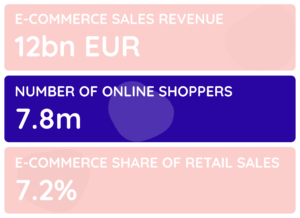For retailers and consumers, the COVID-19 pandemic was an incentive to venture into the e-commerce arena. Even among those previously skeptical of buying and selling online, the 2020 crisis left little choice but to shift consumption to the digital sphere. This resulted in 20,000 new online stores in 2020 and 56,000 in 2021. In 2021, nearly two-thirds of the Belgian population indicated that they buy products and services online, up from just over half before the coronavirus outbreak. 2021 also saw a +18% increase in online sales. E-commerce turnover in Belgium has also seen unprecedented results, crossing the €12 billion mark by the end of 2021. (Source: Statista: E-commerce in Belgium – statistics and facts)
Some key figures

(Source: Statista: E-commerce in Belgium – statistics and facts)
Online buying behavior of the Belgian consumer after COVID-19
We can already observe some important trends in the online buying behavior of Belgian consumers in the first half of 2022:
1. Belgians embrace omnichannel
More than half of Belgians say that for products over 25 euros, they will first look up information online about the price. 38% look up online whether the product is available in the store and 47% search the Internet for reviews. Even when shopping in the store itself, 1 in 3 Belgians (31%) check the price via their smartphone, they also check availability and read reviews. In total 17% have bought in the store to be delivered to their home. (Source: https://static.comeos.be/img/Ecommerce2022.pdf)
2. Platforms continue to grow
The number of Belgian merchants using the Bol.com online e-commerce platform has doubled in two years from 2,600 to over 5,400 sales partners. These figures are in line with several studies on the Belgian e-commerce landscape, which show that over the past five years, more and more entrepreneurs have taken the plunge into online sales. Over 88% of Flemish people have made a purchase on Bol.com. Among French speakers, 82% have used Amazon. More than half of all Belgians (59%) use Zalando.
The platforms are a success and have a particularly strong market share that continues to grow. (Source: Febweb.be: Research: E-commerce after Corona)
Discover more about Marketplaces as the next step in your international growth: advantages and disadvantages.
3. Social selling
Facebook and instagram are the main sources for completing purchases directly from a social media network. If we look only at generation Z, Instagram is in the lead. Although here we can observe an important trend: Tik Tok is already in second place among the generation Z! (Source: Statista: E-commerce in Belgium – statistics and facts)
Over 30% of consumers have bought a product in the past quarter after seeing it on social media, monthly this is 33%. So says research from Klarna. About half of them also buy directly via social media. The main reasons for which customers choose to shop online are that they can save time (77%), compare prices better (76%) and enjoy a wider range and lower prices (71%). More social interaction (84%) and better customer service (75%) are reasons for physical shopping. (Source: Gondola.be: 1 in 3 Belgians seduced to buy by social media
Discover more about the emerge of social shopping and how to implement it on your channels.
The Dot Society benchmarks
Looking at The Dot Society benchmarks, we see an overall average growth of +37% YoY in the first part of 2022, thanks to the investments made in the past years and the current year in tactically attracting new customers and transforming them into loyal ones. We do see a clear impact of the reopening of the stores, war in Ukraine and a more expensive cost of living, on the conversion ratio of the average webshop. Here we see a year-on-year decrease of -25%, which indicates that customers use the webshop as a window or think a bit longer about a certain purchase. As a result, we need to look closely at the entire funnel. It becomes more expensive to attract new customers, making it all the more important to increase their customer lifetime value. Depending on whether the company also has a physical store, the numbers may vary. We see a clear movement after Covid that the webshop is often used as a window and the effective conversion being done in the store. As a result, sales can shift again from online to offline. It thus becomes super important to look at your omnichannel data (offline + online sales) and analyze this as a whole instead of 2 separate cilo’s in order to draw the right conclusions. (Source: The Dot Society benchmarks H1 2022)
This post is also available in: Dutch




